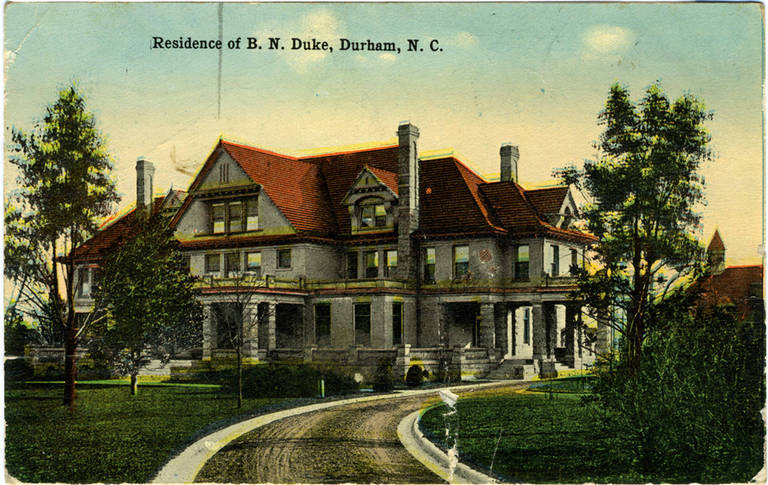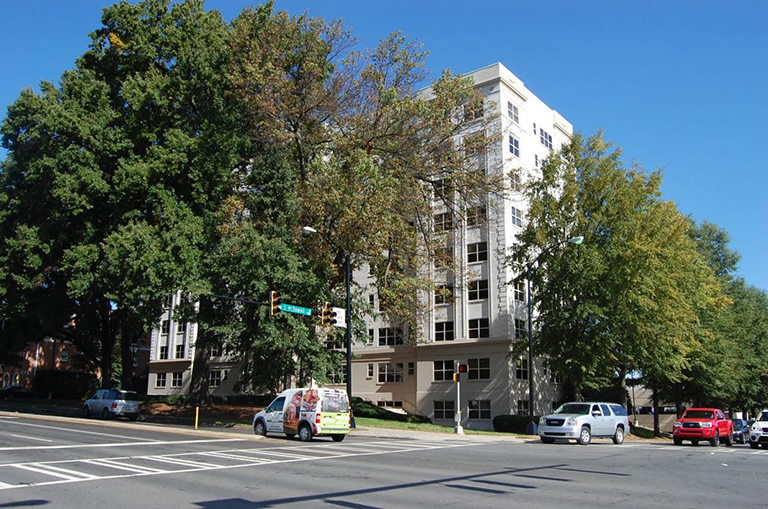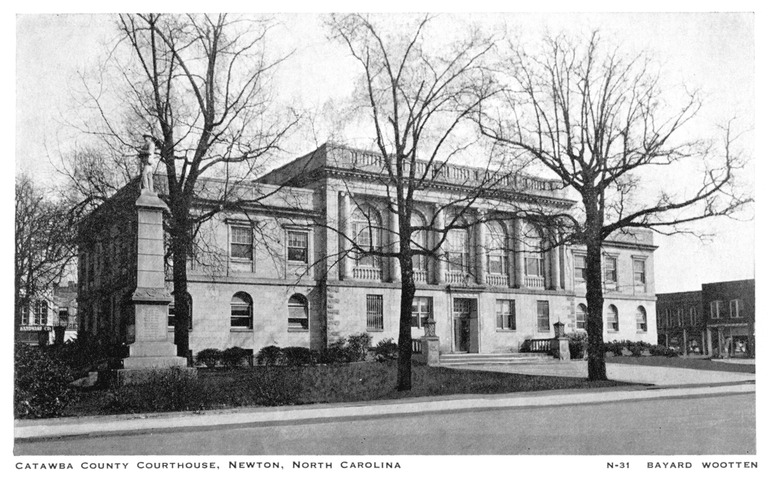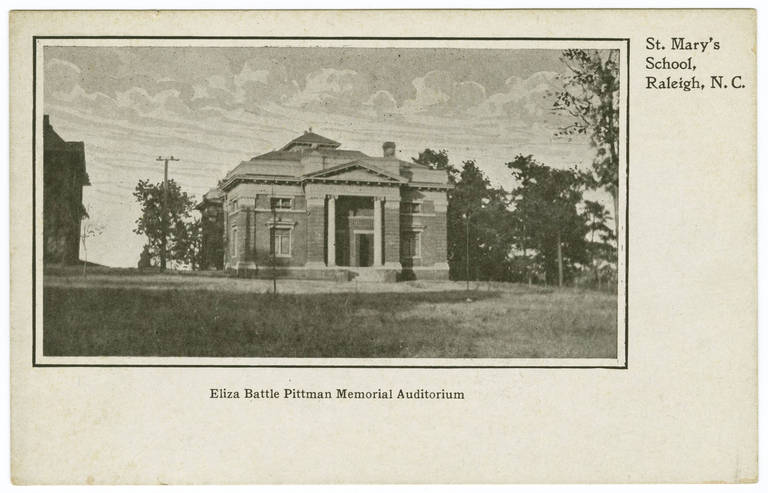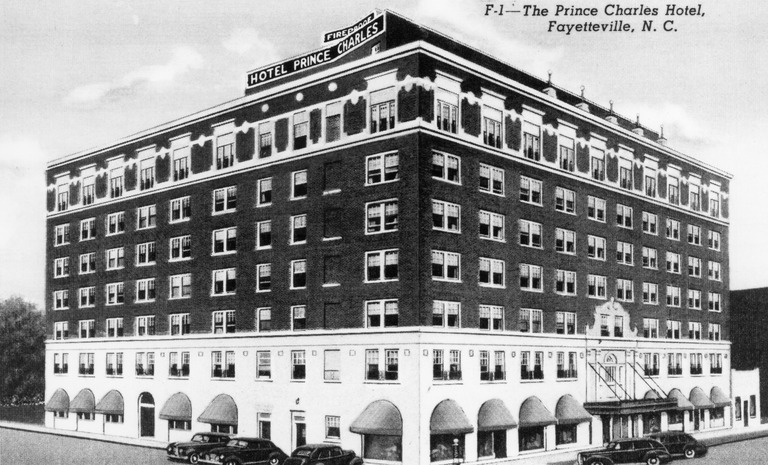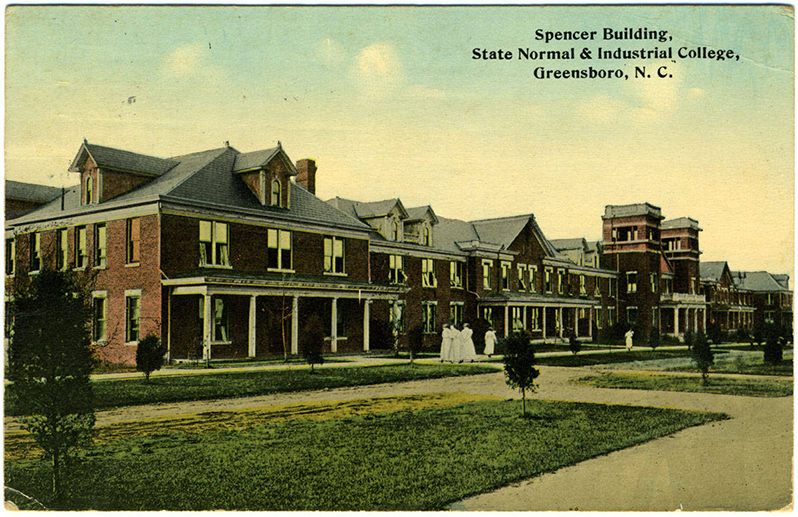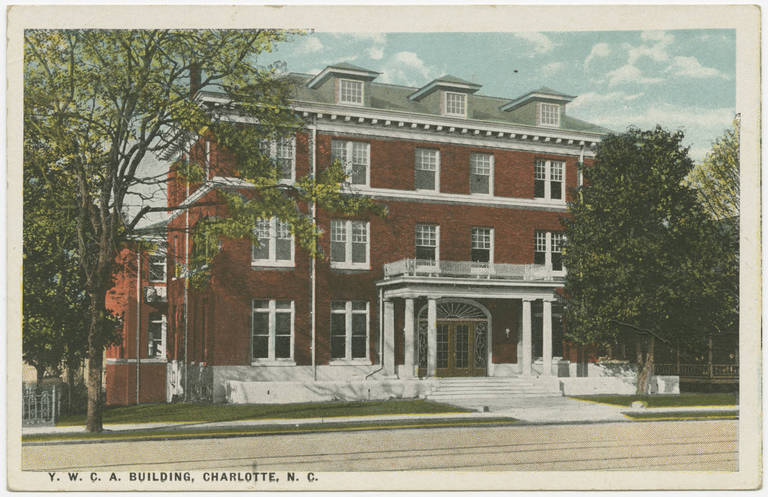Rogers, Willard G. (1863?-1947)
Birthplace:
Cincinnati, Ohio, USA
Residences:
- Charlotte
Trades:
- Architect
Building Types:
Styles & Forms:
Egyptian Revival; Mission; Renaissance Revival
Willard G. Rogers (1863?-1947), a native of Cincinnati, practiced architecture in Charlotte, N. C. for many years, for a time as a partner in Hook and Sawyer with Charles Christian Hook and then on his own.
Relatively little is known of Willard G. Rogers’s early life. According to a biographical dictionary of Cincinnati architects he was the son of architect Solomon Willard Rogers and grandson of the famed Massachusetts and Ohio architect Isaiah Rogers. Willard presumably learned his profession from his father.
Solomon Willard Rogers and his family moved about during Willard’s youth. The United States Census of 1880 showed Willard G. Rogers, aged 18, in Tate, Ohio, the son of Solomon W. and Susan Rogers; Solomon was identified as a native of Connecticut and a farmer. The family moved to Atlanta, where city directories show them in the early 1890s. In 1900 Solomon Rogers was living in Mississippi, identified as an architect from Connecticut, working as an architect, and living at a boarding house. The rest of the family may have stayed in Georgia; in 1900, Solomon W. Rogers, architect from Massachusetts, aged 71 and his wife Susan Rogers, aged 66, were living in Edgewood, DeKalb, Georgia. The 1910 census, which recorded Willard G. Rogers as an architect in Charlotte, put his birth year at about 1866 and his father’s birthplace as Massachusetts.
Around 1900 Willard G. Rogers and his wife Eva, a native of Kentucky, moved to Charlotte, where he soon affiliated with the growing city’s leading figures. He worked initially as an architect for the engineering firm of Stuart W. Cramer. In 1905, he joined architect Charles Christian Hook in the architectural firm of Hook and Rogers. Hook and Rogers’s practice, which continued until 1916, covered a broad area and included a wide range of building types and styles including many college projects.
Rogers was active in professional organizations. In 1912 he served as president of the North Carolina Architectural Association, of which William H. Lord of Asheville was vice-president and Franklin Gordon of Charlotte was secretary-treasurer. He was also a Scottish Rite Mason as early as 1913. Mrs. Rogers’s social activities and travels were frequently noted in the pages of the Charlotte newspapers.
After Rogers’s partnership with Hook ended, he went on to practice on his own. Beginning in 1916, he frequently advertised his services as a “registered architect” with his office at 502 Trust Building in Charlotte newspapers. In 1921, he advertised that he had an office in Charlotte and another in Kinston, North Carolina, where Liston L. Mallard was the manager, thus enabling the firm to accomplish projects in eastern North Carolina.
Rogers’s work on his own encompassed a variety of building types, especially in the western Piedmont. Several were among the most prominent in their communities at the time, including courthouses and leading banks. Rogers appeared regularly in Charlotte city directories as an architect, and in 1940, the United States Census recorded Rogers, an architect aged 71, and his wife Eva, aged 62, still residing in Charlotte. Shortly after this, he moved to Atlanta, where he died on November 28, 1947, aged 83.
- Catherine W. Bishir and Michael T. Southern, A Guide to the Historic Architecture of Piedmont North Carolina (2003).
- Thomas W. Hanchett and William B. Huffman, “W. G. Rogers House” (1984), Charlotte-Mecklenburg Historic Landmarks Commission Survey & Research Reports, http://www.cmhpf.org/S&Rs%20Alphabetical%20Order/surveys&rrogershouse.htm.
- William H. Huffman, Dan L. Morrill and Sherry J. Joines, “The Addison Apartments” (1994), Charlotte-Mecklenburg Historic Landmarks Commission Survey & Research Reports, http://www.cmhpf.org/S&Rs%20Alphabetical%20Order/surveys&raddison.htm.
Abel Caleb Lineberger Sr. House I
Contributors:Dates:1910
Location:Belmont, Gaston CountyStreet Address:203 N. Main St., Belmont, NC
Status:Standing
Type:Residential
Images Published In:Kim Withers Brengle, The Architectural Heritage of Gaston County, North Carolina (1982).
Addison Apartments
Contributors:J. A. Jones, builder; Willard G. Rogers, architectDates:1926
Location:Charlotte, Mecklenburg CountyStreet Address:831 W. Morehead St., Charlotte, NC
Status:Standing
Type:Residential
Note:The J. A. Jones Construction Company acquired two lots at the corner of E. Morehead and McDowell Streets in 1922, a key location in the expansion of the Dilworth suburb. J. A. Jones formed a real estate company with his sons to develop the apartment building, which was designed by architect Willard G. Rogers, who had previously been in partnership with architect C. C. Hook. The company and the building were given the name Addison, J. A. Jones’s middle name. See Charlotte Historic Properties Report for the Addison Apartments by William H. Huffman, Dan L. Morrill, and Sherry J. Joines (1994, 1997) at http://www.cmhpf.org/S&Rs%20Alphabetical%20Order/surveys&raddison.htm.
Adler Brothers Building
Contributors:Willard G. Rogers, architectDates:1922
Location:Kinston, Lenoir CountyStreet Address:126-128 N. Queen St., Kinston, NC
Status:Unknown
Type:Commercial
Note:The 4-story Adler Brothers Building was announced in the Kinston Daily Free Press as one of eastern North Carolina’s largest department stores, with a front of glass and polychrome terra cotta. Architect Liston Mallard was directly involved, as “eastern manager” for architect Rogers.
Banks Presbyterian Church
Contributors:J. D. Foard, contractor; C. C. Hook, architect; Hook and Rogers, architects; Willard G. Rogers, architectDates:1911
Location:Union CountyStreet Address:SR 1315, Marvin, NC
Status:Standing
Type:Religious
Images Published In:Suzanne S. Pickens, ed., Sweet Union: An Architectural and Historical Survey of Union County, North Carolina (1990).
Catawba County Courthouse
Contributors:T. R. Owens, builder; Willard G. Rogers, architectDates:1924
Location:Newton, Catawba CountyStreet Address:Courthouse Square, Newton, NC
Status:Standing
Type:Public
Images Published In:Catherine W. Bishir and Michael T. Southern, A Guide to the Historic Architecture of Piedmont North Carolina (2003).
Note:The Renaissance Revival style edifice is faced in Indiana limestone.
Chapel Hill Graded School
Contributors:Dates:1915
Location:Chapel Hill, Orange CountyStreet Address:Franklin St., Chapel Hill, NC
Status:No longer standing
Type:Educational
Note:The school was located on Franklin Street, southwest of the intersection with Columbia Street, where University Square is currently. It became Chapel Hill High School in 1936, and was demolished in the 1970s.
Cole Manufacturing Plant
Contributors:Dates:1909-1911
Location:Charlotte, Mecklenburg CountyStreet Address:Charlotte, NC
Status:Standing
Type:Industrial
D. L. Bost House
Contributors:Dates:1905
Location:Concord, Cabarrus CountyStreet Address:154 S. Union St., Concord, NC
Status:Standing
Type:Residential
Images Published In:Peter R. Kaplan, The Historic Architecture of Cabarrus County, North Carolina (2004).
East Duke Building
Contributors:Dates:Ca. 1910
Location:Durham, Durham CountyStreet Address:Duke University, Durham, NC
Status:Standing
Type:Educational
Images Published In:Claudia P. Roberts (Brown) and Diane E. Lea, The Durham Architectural and Historic Inventory (1982).
Note:The East Duke Building is the right, tan-colored building pictured in the bottom right corner of the image.
Eliza Pittman Memorial Auditorium
Contributors:Dates:Ca. 1906
Location:Raleigh, Wake CountyStreet Address:St. Mary’s School, Hillsborough St., Raleigh, NC
Status:Standing
Type:Educational
Images Published In:Linda L. Harris and Mary Ann Lee, An Architectural and Historical Inventory of Raleigh, North Carolina (1978).
First Baptist Church
Contributors:Willard G. Rogers, architectDates:1918
Location:Gastonia, Gaston CountyStreet Address:201 W. Franklin Blvd., Gastonia, NC
Status:Standing
Type:Religious
Images Published In:Piper Peters Aheron, Gastonia and Gaston County, North Carolina (2001).
Note:The brick church with tile roof is an unusual use of the Mission style in a church in Piedmont North Carolina.
First National Bank of Cherryville
Contributors:Willard G. Rogers, architectDates:1916
Location:Cherryville, Gaston CountyStreet Address:100 S. Mountain St., Cherryville, NC
Status:Standing
Type:Commercial
Four Acres
Contributors:Variant Name(s):Benjamin N. Duke House
Dates:1908
Location:Durham, Durham CountyStreet Address:Chapel Hill St. at Duke St., Durham, NC
Status:No longer standing
Type:Residential
Images Published In:Joel A. Kostyu and Frank A. Kostyu, Durham: A Pictorial History (1978).
Note:The immense residence called Four Acres was built for tobacco industrialist Benjamin N. Duke on the site of his previous residence. The North Carolina Mutual Insurance building now occupies the elevated, prominent site.
Greystone
Contributors:Variant Name(s):James F. Stagg House
Dates:1911
Location:Durham, Durham CountyStreet Address:618 Morehead Ave., Durham, NC
Status:Standing
Type:Residential
Images Published In:Joel A. Kostyu and Frank A. Kostyu, Durham: A Pictorial History (1978).
Claudia P. Roberts (Brown) and Diane E. Lea, The Durham Architectural and Historic Inventory (1982).Note:Built for an associate of the Duke family, Greystone is one of the few examples surviving of Durham’s pre-1920 mansions.
Jarvis Hall
Contributors:C. C. Hook, architect; Hook and Rogers, architects; Willard G. Rogers, architect; Herbert W. Simpson, architect; C. V. York, contractorDates:1909
Location:Greenville, Pitt CountyStreet Address:East Carolina University, Greenville, NC
Status:Standing
Type:Educational
Images Published In:Michael Cotter, ed., The Architectural Heritage of Greenville, North Carolina (1988).
Note:Jarvis Hall is one of the most intact of several buildings designed at present East Carolina University by Hook and Rogers and Herbert W. Simpson, typically in red brick with red tile roofs. The college was established in 1907, and these architects designed the earliest part of the campus.
John Blue House
Contributors:C. C. Hook, attributed architect; Hook and Rogers, attributed architects; Willard G. Rogers, attributed architectDates:Ca. 1888; 1903
Location:Aberdeen, Moore CountyStreet Address:200 Blue St., Aberdeen, NC
Status:No longer standing
Type:Residential
John Love Buildings
Contributors:C. C. Hook, attributed architect; Hook and Rogers, attributed architects; Hook and Sawyer, attributed architects; Willard G. Rogers, attributed architect; Frank M. Sawyer, attributed architectDates:1904; ca. 1906-1908
Location:Gastonia, Gaston CountyStreet Address:213-223 W. Main Ave., Gastonia, NC
Status:Standing
Type:Commercial
Images Published In:Kim Withers Brengle, The Architectural Heritage of Gaston County, North Carolina (1982).
Note:In 1899 and 1906 the Manufacturers’ Record carried news of Hook’s firms designing office buildings for John Love, which may be these.
Lenoir Building
Contributors:Dates:Ca. 1908
Location:Lenoir, Caldwell CountyStreet Address:808 West Ave., Lenoir, NC
Status:Standing
Type:Commercial
Images Published In:Catherine W. Bishir, Michael T. Southern, and Jennifer F. Martin, A Guide to the Historic Architecture of Western North Carolina (1999).
Masonic Building
Contributors:J. P. Little and Son, builders; Willard G. Rogers, architectDates:1923
Location:Shelby, Cleveland CountyStreet Address:203 S. Washington St., Shelby, NC
Status:Standing
Type:Fraternal
Note:The building of buff colored brick is one of the state’s chief examples of Egyptian Revival style, with lotus columns and a frieze of wings. It recalls the imposing Masonic Building (1914) in Charlotte planned by Hook and Rogers.
Masonic Building
Contributors:C. C. Hook, architect; Hook and Rogers, architects; Willard G. Rogers, architect; Herbert W. Simpson, architectDates:1902
Location:Greenville, Pitt CountyStreet Address:Greenville, NC
Status:No longer standing
Type:Fraternal
Images Published In:Michael Cotter, ed., The Architectural Heritage of Greenville, North Carolina (1988).
Masonic Temple
Contributors:C. C. Hook, architect; Hook and Rogers, architects; J. A. Jones, builder; Willard G. Rogers, architectDates:1914
Location:Charlotte, Mecklenburg CountyStreet Address:329 S. Tryon St., Charlotte, NC
Status:No longer standing
Type:Fraternal
Images Published In:Mary Norton Kratt and Mary Manning Boyer, Remembering Charlotte: Postcards from a New South City, 1905-1950 (2000).
Note:The imposing Egyptian Revival style Masonic temple was among the state’s premier examples of its style and type. It was razed in 1987, and its massive lotus columns were reused in Rock Hill, South Carolina.
Misenheimer-James House
Contributors:C. C. Hook, architect (1915); Hook and Rogers, architects (1915); Robert Franklin Lynn, stonemason (1915); Willard G. Rogers, architect (1915)Dates:Late 19th century; 1915 [remodeled]
Location:Mount Pleasant, Cabarrus CountyStreet Address:311 S. Main St., Mount Pleasant, NC
Status:Standing
Type:Residential
Images Published In:Peter R. Kaplan, The Historic Architecture of Cabarrus County, North Carolina (2004).
Note:The eclectic house and its outbuildings constitute the principal ensemble of fine stonework by Robert Franklin Lynn, in this case in an architect-designed house built for a leading white citizen. The complex began with a simpler house built for J. J. Misenhimer, but it was greatly altered as the residence of industrialist Augustus N. James who moved to Mount Pleasant from Charlotte. He employed the Charlotte architectural firm of Hook and Rogers to redesign the house in a combination of Craftsman and Colonial Revival modes. Its special character derives from the abundant use of Lynn’s stonework for the foundation, porches, outbuildings, and a retaining wall as well as a fireplace.
National Bank of Fayetteville
Contributors:Stiles S. Dixon, architect; Willard G. Rogers, architectDates:1922
Location:Fayetteville, Cumberland CountyStreet Address:Fayetteville, NC
Status:Unbuilt
Type:Commercial
Note:Among the projects cited to Rogers in the Manufacturers’ Record was the 13-story National Bank in Fayetteville, in association with Stiles S. Dixon (Manufacturers’ Record July 13, 1922). The Fayetteville Observer reported on June 27 that the company planned to build a 10 or 12-story bank, and that on display was a picture of a bank building “drawn by Willard G. Rogers of Charlotte and Stiles S. Dixon of Fayetteville, and presented to the bank,” giving an idea of the future building. This project evidently stalled. A short time later, the 10-story National Bank of Fayetteville (1923-1926) was built from designs by Charles C. Hartmann of Greensboro. The building was 10 stories tall. Whether the 1922 design influenced its design is unknown.
Piedmont and Northern Railway Depot
Contributors:Dates:1915
Location:Belmont, Gaston CountyStreet Address:4 N. Main St., Belmont, NC
Status:Standing
Type:Transportation
Images Published In:Catherine W. Bishir and Michael T. Southern, A Guide to the Historic Architecture of Piedmont North Carolina (2003).
Kim Withers Brengle, The Architectural Heritage of Gaston County, North Carolina (1982).
Prince Charles Hotel
Contributors:Stiles S. Dixon, architect; Willard G. Rogers, architectDates:1923-1925
Location:Fayetteville, Cumberland CountyStreet Address:430 Hay St., Fayetteville, NC
Status:Standing
Type:Commercial
Images Published In:Catherine W. Bishir and Michael T. Southern, A Guide to the Historic Architecture of Eastern North Carolina (1996).
Note:The large hotel is typical of the era in fireproof construction covered in red brick with classical details. It was named for “Bonnie Prince Charlie,” the figure much celebrated in local lore in a county and region settled by Highland Scots in the 18th century.
Proctor Hotel
Contributors:Variant Name(s):Minges Building
Dates:1912
Location:Greenville, Pitt CountyStreet Address:300 block S. Evans St., Greenville, NC
Status:Altered
Type:Commercial
Images Published In:Michael Cotter, ed., The Architectural Heritage of Greenville, North Carolina (1988).
Rankin Apartments
Contributors:Willard G. Rogers, architectDates:1921
Location:Charlotte, Mecklenburg CountyStreet Address:East Ave. and Davidson St., Charlotte, NC
Status:Unknown
Type:Residential
Note:In 1921, several local businessmen formed the Rankin Apartments Company, which proposed to build an 8-story, modern apartment building for which Rogers drew the plans. The Charlotte News of March 16, 1921, referred to it as the “Million Dollar Apartment House” with “many new features.” It is not clear whether the project was accomplished.
Spencer Hall
Contributors:William Carter Bain, contractor; C. C. Hook, architect; Hook and Rogers, architects; Hook and Sawyer, architects; Willard G. Rogers, architect; Frank M. Sawyer, architectVariant Name(s):New Dormitory
Dates:1904;1907
Location:Greensboro, Guilford CountyStreet Address:University of North Carolina at Greensboro, Greensboro, NC
Status:Standing
Type:Educational
Images Published In:Marvin A. Brown, Greensboro: An Architectural Record (1995).
Note:Spencer Hall is the principal surviving building by Hook and Sawyer at present University of North Carolina Greensboro (the State Normal and Industrial College), where Hook also planned other buildings including an auditorium, a library, and other dormitories. When completed it was described as largest women’s dormitory in the country under one roof. The Julius Isaac Foust Papers at the University of North Carolina at Greensboro University Archives and Manuscripts includes correspondence with the firm of Hook and Rogers (1910s) and Thomas Sears (1920s) about campus buildings and landscaping.
VanLandingham House
Contributors:Dates:1913
Location:Charlotte, Mecklenburg CountyStreet Address:2010 The Plaza, Charlotte, NC
Status:Standing
Type:Residential
West Duke Building
Contributors:Dates:Ca. 1910
Location:Durham, Durham CountyStreet Address:Duke University, Durham, NC
Status:Standing
Type:Educational
Images Published In:Claudia P. Roberts (Brown) and Diane E. Lea, The Durham Architectural and Historic Inventory (1982).
Note:The West Duke Building is the left, tan-colored building pictured in the bottom right corner of the image.
Willard G. Rogers House
Contributors:Willard G. Rogers, architectDates:Ca. 1907
Location:Charlotte, Mecklenburg CountyStreet Address:524 East Blvd., Charlotte, NC
Status:Standing
Type:Residential
Note:Rogers designed the shingled, gambrel roofed dwelling as his and his wife’s residence.
YWCA Building
Contributors:Dates:1912-1914
Location:Charlotte, Mecklenburg CountyStreet Address:418 E. Trade St., Charlotte, NC
Status:No longer standing
Type:Recreational
Images Published In:Mary Norton Kratt and Mary Manning Boyer, Remembering Charlotte: Postcards from a New South City, 1905-1950 (2000).

